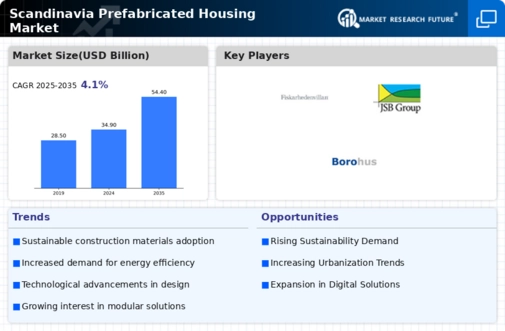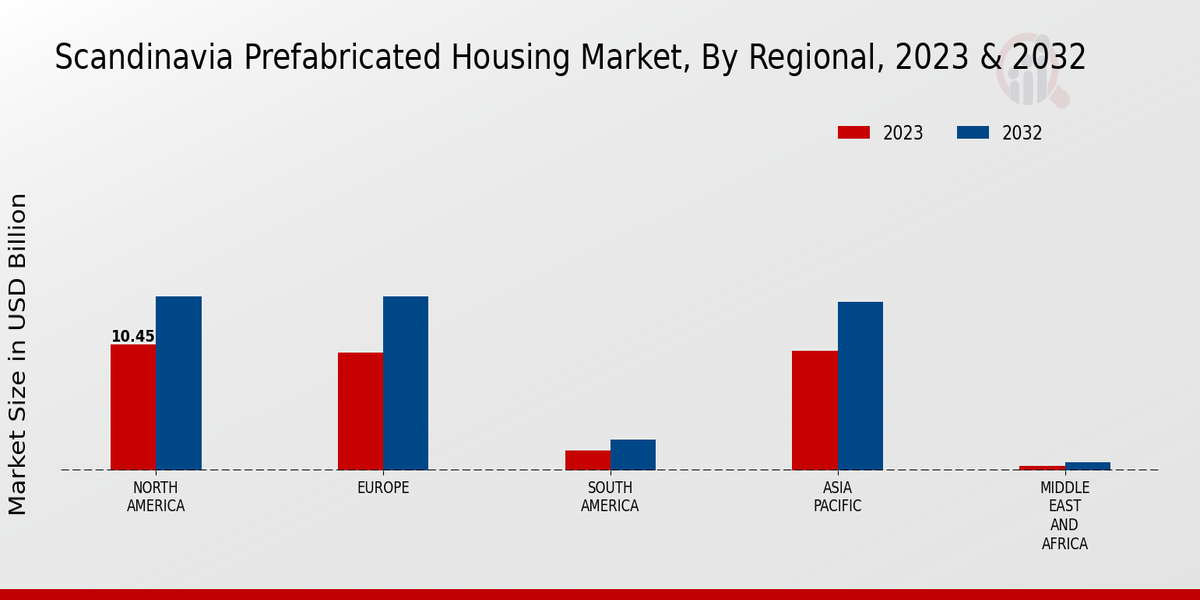Urbanization Trends
Urbanization trends significantly influence the Global Scandinavia Prefabricated Housing Market Industry. As more people migrate to urban areas, the demand for affordable and efficient housing solutions increases. Prefabricated homes offer a viable option to address housing shortages in densely populated cities. Scandinavian countries, known for their progressive urban planning, are increasingly incorporating prefabricated housing into their development strategies. This shift not only meets housing demands but also aligns with sustainable urban growth initiatives. The market is expected to grow at a CAGR of 4.12% from 2025 to 2035, reflecting the ongoing need for innovative housing solutions in urban environments.
Market Growth Projections
The Global Scandinavia Prefabricated Housing Market Industry is characterized by robust growth projections. With a market value anticipated to reach 34.9 USD Billion in 2024 and further expand to 54.4 USD Billion by 2035, the industry demonstrates a promising trajectory. This growth is underpinned by various factors, including technological advancements, urbanization trends, and changing consumer preferences. The projected CAGR of 4.12% from 2025 to 2035 suggests a steady increase in demand for prefabricated housing solutions. Such figures indicate a vibrant market landscape, reflecting the increasing acceptance and integration of prefabricated homes within the broader housing sector.
Technological Advancements
Technological advancements play a crucial role in shaping the Global Scandinavia Prefabricated Housing Market Industry. Innovations in construction technology, such as modular design and automated manufacturing processes, enhance efficiency and reduce costs. These advancements enable faster construction timelines and improved quality control, appealing to both builders and consumers. For example, the integration of Building Information Modeling (BIM) allows for precise planning and execution, minimizing waste and errors. As these technologies continue to evolve, they are likely to drive market growth, with projections indicating a market size of 54.4 USD Billion by 2035, highlighting the potential for further expansion.
Changing Consumer Preferences
Changing consumer preferences are reshaping the Global Scandinavia Prefabricated Housing Market Industry. Modern buyers increasingly seek customizable, efficient, and sustainable housing options. Prefabricated homes cater to these demands by offering a range of designs and features that can be tailored to individual needs. This flexibility appeals to a diverse demographic, from young professionals to families seeking affordable housing solutions. Additionally, the emphasis on energy efficiency and reduced environmental impact aligns with contemporary values. As these preferences continue to evolve, the market is likely to experience sustained growth, with projections indicating a market size of 54.4 USD Billion by 2035.
Sustainable Building Practices
The Global Scandinavia Prefabricated Housing Market Industry is increasingly driven by the adoption of sustainable building practices. As environmental concerns gain prominence, prefabricated housing offers a more eco-friendly alternative to traditional construction methods. These homes are often built using sustainable materials and energy-efficient designs, which can significantly reduce carbon footprints. For instance, many Scandinavian countries have implemented stringent regulations promoting sustainability in construction. This trend is expected to contribute to the market's growth, with the industry projected to reach 34.9 USD Billion in 2024, reflecting a growing consumer preference for environmentally responsible housing solutions.
Government Initiatives and Support
Government initiatives and support are pivotal in driving the Global Scandinavia Prefabricated Housing Market Industry. Many Scandinavian governments actively promote prefabricated housing through subsidies, tax incentives, and favorable regulations. These measures aim to encourage sustainable construction practices and address housing shortages. For instance, various programs have been launched to facilitate the adoption of prefabricated homes in rural and urban areas alike. Such government backing not only boosts consumer confidence but also stimulates market growth. As a result, the industry is poised for expansion, with a projected market value of 34.9 USD Billion in 2024, indicating strong governmental influence on housing trends.















Leave a Comment